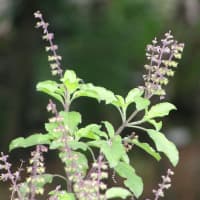Holy Basil (Ocimum tenuiflorum syn Ocimum sanctum) is also known as tulsi or tulasi.
Composition
Healing Properties
Adaptogen
Analgesic (Pain relief)
Antimicrobial
Antifungal
Antiviral (anti-viral)
Antioxidant
Antispasmodic
Brain Health
Attention
Tulsi treatment was shown to significantly improve willingness of adjustment and attention in humans.[2]
Behavior
Tulsi has potential actions in the regulation of hypothalamo-hypophyseal-adrenocortical axis (HHA axis) especially, during stress related disorders in humans.[2:1]
Cerebral Stimulant
Neuroprotective
Cardiovascular Health
Antilipemic (Lowers Cholesterol)
Promotes a healthy lipid profile.
Digestive Aid
Expectorant
Immunomodulator
Oral Health
Irrigation with Tulsi extract has beneficial effect on plaque control and gingival health and is at par with the gold standard of chlorhexidine.[3]
Relaxing (calms nerves)
Disease & Symptom Treatment
Allergic rhinitis
Anxiety
Tulsi has good efficacy to negate anxiety related disorders in human subjects.[2:2]
Tulsi may be a promising anxiolytic agent and a safer alternative to Benzodiazepines for the therapy of stress related clinical disorders.[2:3]
- Tulsi significantly attenuated generalized anxiety disorders and also attenuated its correlated stress and depression.
- It significantly improved attention and the willingness to adjustment.
Colds and flu
Depression
Depression index was also reduced after two-months of continuous treatment with Tulsi (O. sanctum).[2:4]
Tulsi treatment significantly improved the willingness of adjustment and attention in human subjects.[2:5]
Diabetes
Insulin resistance
Gingivitis
Irrigation with Tulsi extract has beneficial effect on plaque control and gingival health and is at par with the gold standard of chlorhexidine.[3:1]
Fungal Infections
Head Trauma
Holy Basil may help speed up recovery from head trauma.
Cardiovascular Disease
Atherosclerosis
High Blood Pressure
High Cholesterol (Hyperlipidemia, Hypercholesterolemia)
The content of polyphenol compounds such as flavonoids and tannins in basil leaves can reduce total cholesterol levels and inhibit fat oxidation which is the cause of atherosclerosis.[1:4]
Hyperactivity disorder (ADHD)
Tulsi treatment significantly improved the willingness of adjustment and attention in human subjects.[2:6]
Pain
Stress
Tulsi (O. sanctum) has significant anti-stress and anxiolytic properties.[2:7]
Tulsi extract showed overall improvement in stress management.[2:8]
Two-months of regular administration with O. sanctum reduced stress, attenuated anxiety, negated depression and enhanced adjustment and attention in human subjects.[2:9]
- These observations clearly indicate that O. sanctum has potential action in the regulation of hypothalamo-hypophyseal-adrenocortical axis (HHA axis) especially, during stress related disorders in human.[2:10]
Ulcers
Viral Infections
Herpes virus
Title: A review of medicinal and aromatic plants and their secondary metabolites status under abiotic stress
Publication: Journal of Medicinal Plants Studies
Date: April 2019
Study Type: Review
Author(s): Andleeb Zehra, Sadaf Choudhary, M Naeem, M Masroor A, Khan and Tariq Aftab
Institution(s): Aligarh Muslim University, Aligarh, Uttar Pradesh, India
Copy: archive, archive-mirror ↩︎ ↩︎ ↩︎ ↩︎ ↩︎Title: Controlled programmed trial of ocimum sanctum leaf on generalized anxiety disorders
Publication: Journal of Nepal Medical College
Date: 2008
Study Type: Human Study, Clinical Case Report
Author(s): D Bhattacharyya, TK Sur, U Jana, and PK Debnath
Institution(s): JB Roy State Ayurvedic Medical College and Hospital, Kolkata, India
↩︎ ↩︎ ↩︎ ↩︎ ↩︎ ↩︎ ↩︎ ↩︎ ↩︎ ↩︎ ↩︎Title: Comparative evaluation of clinical effects of simultaneous ultrasonic scaling and irrigation with medicated water containing 2% Occimum sanctum on gingivitis A Clinical Intervention Study
Publication: Journal of Advanced Medical and Dental Sciences Research
Date: June 2019
Study Type: Human Study, Clinical Case Report
Author(s): Deepti Gattani, Saurabh Lingala, Grishmi Niswade, Jigyasa Sahu, Nupur Kar
Institution(s): Swargiya Dadasaheb Kalmegh Smruti Dental College and Hospital, Nagpur, India
Copy: archive, archive-mirror ↩︎ ↩︎
